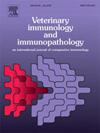Evaluation of clinical and immunological responses to recombinant canine interleukin-15 therapy in dogs with cancer: A pilot study
IF 1.4
3区 农林科学
Q4 IMMUNOLOGY
引用次数: 0
Abstract
Interleukin-15 (IL-15) is a pleiotropic cytokine that plays a pivotal role in innate and adaptive immunity. Therefore, it is a promising therapeutic agent for cancer treatment. Despite growing interest in the use of IL-15 as an immunotherapeutic agent, there have been very few reports on its immunological and clinical effects in canine cancers. In this study, we generated recombinant canine IL-15 (rcIL-15) and evaluated its clinical and immunomodulatory effects in combination with metronomic cyclophosphamide in 15 canines with various tumor types. The treatment outcomes were assessed in a prospective clinical trial. Low-dose cyclophosphamide (12.5 mg/m2, PO, SID) was continuously administered for 8 weeks. Starting on day 14, after administering cyclophosphamide, rcIL-15 (20 μg/kg daily) was injected intravenously for 8 days. The disease control rate for combination therapy was 66.6 %, with the most notable partial response accounting for 33.3 % of hematological malignancies. The adverse events were minimal and primarily of grade 1 severity. Moreover, rcIL-15 administration led to significant elevations in anticancer lymphocyte subsets, such as natural killer and cytotoxic T cells, along with increased Ki-67 expression, indicating cellular proliferation. These changes were correlated with improved clinical outcomes. Our findings underscore the therapeutic potential and safety of combining rcIL-15 and metronomic cyclophosphamide for the treatment of various canine cancers.
评估重组犬白介素-15治疗犬癌症的临床和免疫反应:一项初步研究
白细胞介素-15 (IL-15)是一种多效性细胞因子,在先天免疫和适应性免疫中起关键作用。因此,它是一种很有前途的治疗癌症的药物。尽管人们对IL-15作为一种免疫治疗剂的使用越来越感兴趣,但关于其在犬癌症中的免疫学和临床效果的报道很少。在本研究中,我们制备了重组犬IL-15 (rcIL-15),并在15只不同肿瘤类型的犬中评估了其与节拍性环磷酰胺联合使用的临床和免疫调节作用。在一项前瞻性临床试验中评估治疗结果。低剂量环磷酰胺(12.5 mg/m2, PO, SID)连续给药8周。从第14天开始,给药环磷酰胺后,静脉注射rcIL-15(20 μg/kg / d),连续8天。联合治疗的疾病控制率为66.6% %,最显著的部分缓解占血液系统恶性肿瘤的33.3% %。不良事件极少,严重程度主要为1级。此外,rcIL-15给药导致抗癌淋巴细胞亚群(如自然杀伤细胞和细胞毒性T细胞)显著升高,同时Ki-67表达增加,表明细胞增殖。这些变化与临床结果的改善相关。我们的研究结果强调了ril -15联合环磷酰胺治疗各种犬类癌症的治疗潜力和安全性。
本文章由计算机程序翻译,如有差异,请以英文原文为准。
求助全文
约1分钟内获得全文
求助全文
来源期刊
CiteScore
3.40
自引率
5.60%
发文量
79
审稿时长
70 days
期刊介绍:
The journal reports basic, comparative and clinical immunology as they pertain to the animal species designated here: livestock, poultry, and fish species that are major food animals and companion animals such as cats, dogs, horses and camels, and wildlife species that act as reservoirs for food, companion or human infectious diseases, or as models for human disease.
Rodent models of infectious diseases that are of importance in the animal species indicated above,when the disease requires a level of containment that is not readily available for larger animal experimentation (ABSL3), will be considered. Papers on rabbits, lizards, guinea pigs, badgers, armadillos, elephants, antelope, and buffalo will be reviewed if the research advances our fundamental understanding of immunology, or if they act as a reservoir of infectious disease for the primary animal species designated above, or for humans. Manuscripts employing other species will be reviewed if justified as fitting into the categories above.
The following topics are appropriate: biology of cells and mechanisms of the immune system, immunochemistry, immunodeficiencies, immunodiagnosis, immunogenetics, immunopathology, immunology of infectious disease and tumors, immunoprophylaxis including vaccine development and delivery, immunological aspects of pregnancy including passive immunity, autoimmuity, neuroimmunology, and transplanatation immunology. Manuscripts that describe new genes and development of tools such as monoclonal antibodies are also of interest when part of a larger biological study. Studies employing extracts or constituents (plant extracts, feed additives or microbiome) must be sufficiently defined to be reproduced in other laboratories and also provide evidence for possible mechanisms and not simply show an effect on the immune system.

 求助内容:
求助内容: 应助结果提醒方式:
应助结果提醒方式:


